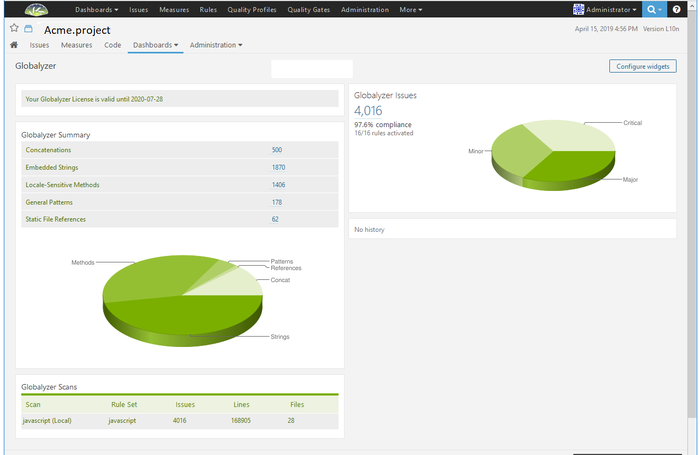Difference between revisions of "Globalyzer CI/CD (Continuous Integration and Continuous Delivery)"
(→Using Globalyzer Lite in a Continuous Globalization System) |
|||
| Line 19: | Line 19: | ||
You may also pass the reports to your own reporting system. |
You may also pass the reports to your own reporting system. |
||
| + | |||
| + | == Using Globalyzer Lite from a command line == |
||
| + | |||
| + | Globalyzer Lite can be executed from a command prompt or shell via the following command: |
||
| + | |||
| + | <code>java -jar globalyzer-lite.jar some_location/YourProjectDefinitionFile.xml</code> |
||
| + | |||
| + | After Globalyzer Lite finishes each scan, a relevant Globalyzer report is created at the location specified in the Project Definition's report path. |
||
| + | |||
| + | Lite also allows for altering the following parameters via command line options: |
||
| + | |||
| + | * The Project Path |
||
| + | * The Report Path |
||
| + | * The Files/Directories to scan |
||
| + | * The location of the Globalyzer License (if using Local Rule Sets) |
||
Revision as of 21:18, 12 June 2019
What is Globalyzer Lite and Globalyzer CI/CD?
Globalyzer Lite is the product that allows users to scan code and create reports without having to use the Globalyzer Workbench or set up a database. In the Lingoport Continuous Globalization Server, Globalyzer Lite (Globalyzer CI/CD) is an integral part of the process to create reports that are displayed in the Lingoport Dashboard showing the number of internationalization issues detected.
Using Globalyzer Lite in a Continuous Globalization System
If the Lingoport Continuous Globalization System was installed and configured using the Stack Installer or Stack Updater, then Globalyzer Lite has already been integrated into the system.
- Check in a project definition file into source control.
- On-board a Jenkins project for the code base using one of the Globalyzer Lite templates like Lingoport.SampleLite or Lingoport.SampleLiteLRM.
- Check the Lingoport Dashboard and verify that the results are shown.
Globalyzer Lite is easy to integrate into other Continuous Integration (CI) systems as well.
- Check in a project definition file into source control (or, if you prefer, place one in the Jenkins server's filesystem).
- Run the following from Jenkins' shell:
java -jar globalyzer-lite.jar -f "${WORKSPACE}/GlobalyzerProjectDefinitionFile.xml" --project-path "${WORKSPACE}" --report-path "globalyzer-lite-reports"
- Use the Lingoport Dashboard to display the results from the generated reports.
You may also pass the reports to your own reporting system.
Using Globalyzer Lite from a command line
Globalyzer Lite can be executed from a command prompt or shell via the following command:
java -jar globalyzer-lite.jar some_location/YourProjectDefinitionFile.xml
After Globalyzer Lite finishes each scan, a relevant Globalyzer report is created at the location specified in the Project Definition's report path.
Lite also allows for altering the following parameters via command line options:
- The Project Path
- The Report Path
- The Files/Directories to scan
- The location of the Globalyzer License (if using Local Rule Sets)
